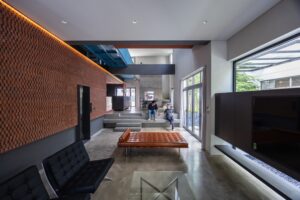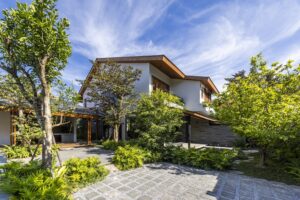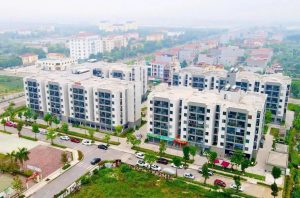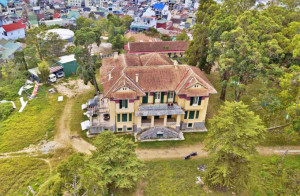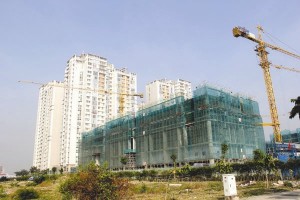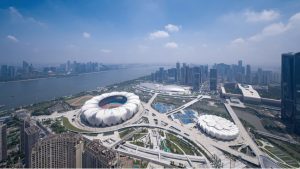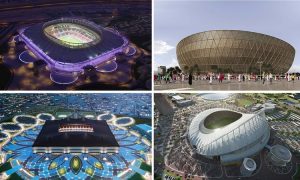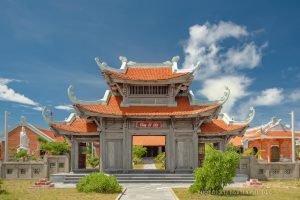Công bố quốc tế trong lĩnh vực kiến trúc, xây dựng (Tuần 1 tháng 10-2021)
Trong số này chúng tôi xin giới thiệu tới quý độc giả những nội dung chính của các công bố quốc tế đăng tải trên ScienceDirect và Springer Nature do Cục Thông tin khoa học và công nghệ quốc gia (NASATI) mua quyền truy cập như sau:
Quy hoạch đô thị:
– Truy tìm và xây dựng các cân nhắc về công bằng môi trường trong tài liệu về dịch vụ hệ sinh thái đô thị: Một đánh giá có hệ thống
– Tắc kè hoa ‘xanh’: Khám phá nhiều định nghĩa, mục tiêu và hình thức kỷ luật của “cơ sở hạ tầng xanh”
– Áp dụng các mô hình dự báo để nghiên cứu các đặc tính sinh thái của hệ sinh thái đô thị: Một nghiên cứu điển hình ở Zürich, Thụy Sĩ
– Các chỉ số phát triển đô thị bền vững ở Anh từ 2001 đến 2016
– Đánh giá khả năng giảm thiểu nhiệt của không gian xanh đô thị với việc sử dụng mô hình làm mát đô thị InVEST, được xác minh với dữ liệu nhiệt độ bề mặt đất ban ngày
– Mô phỏng sự tăng trưởng đất đô thị bằng cách kết hợp thông tin lịch sử vào mô hình tự động dữ liệu di động
– Roofpedia: Lập bản đồ tự động các mái nhà xanh và năng lượng mặt trời nhằm tạo lập cảnh quan mái nhà mở và đánh giá tính bền vững của đô thị
– Ảnh hưởng của các khung mô hình trong quy hoạch không gian kết nối vùng thích ứng với khí hậu để lập kế hoạch bảo tồn
Khoa học và công nghệ trong lĩnh vực kiến trúc, xây dựng:
– Phương pháp chẩn đoán lỗi dựa trên mạng lưới thần kinh tích tụ một chiều ứng dụng cho các hệ thống sưởi, thông gió và điều hòa không khí trong tòa nhà
– Đánh giá các phương pháp tối ưu hóa để điều khiển hệ thống làm mát trung tâm làm mát bằng nước
– Tối ưu hóa thiết bị ngăn chặn bụi phun trong đường hầm gió hồi của mỏ than dựa trên công nghệ CFD
– Chỉ báo Hiệu suất Điều hòa Không khí Toàn cầu (ACPI) cho các tòa nhà ở vùng khí hậu nhiệt đới
– Phát triển mô hình dựa trên vật lý để phân tích lượng khí thải formaldehyde từ vật liệu xây dựng dưới tác động của nhiệt độ và độ ẩm.
– Một nghiên cứu thực địa đầy đủ về giảm thiểu rung động môi trường trên mặt đất bằng cách sử dụng các rãnh mở
– Tối ưu hóa đa mục tiêu của tòa nhà dân cư nhiều tầng với chiến lược thiết kế thụ động ở Hàn Quốc
– Khả năng sử dụng máy điều nhiệt trong khu dân cư: So sánh các thiết bị thủ công, lập trình và thông minh
– Mô hình phát triển giá trị truyền nhiệt trên mái (RTTV) cho mái nhà xanh ở khu vực nhiệt đới: Một nghiên cứu điển hình ở Singapore
– Thí nghiệm hiện trường và khảo sát số liệu về môi trường nhiệt của đường hầm có kết cấu lớp không khí
Vật liệu xây dựng:
– Thu hồi và tái sử dụng sợi carbon và nhựa acrylic từ vật liệu tổng hợp nhiệt dẻo được sử dụng trong ứng dụng hàng hải
– Tái sử dụng bột thủy tinh thải trong bột nhão metakaolin / tro bay hoạt hóa kiềm: Tính chất vật lý, động học phản ứng và cấu trúc vi mô
– Phát triển vật liệu tổng hợp nhiệt dẻo hiệu suất cao dựa trên polyurethane và cao su lốp mài bằng cách tổng hợp tại chỗ
– Sử dụng xỉ thép làm vật liệu xây dựng bền vững: Xem xét lại quá trình xử lý cacbon hóa cấp tốc
– Rà soát kiểm tra không phá hủy dựa trên phương pháp sóng cho kết cấu hỗn hợp thép-bê tông: Mô phỏng đa tỷ lệ và phân tích khớp nối đa vật lý
– Đánh giá về việc sử dụng bùn đỏ để sản xuất geopolymer và bê tông hoạt tính kiềm
– Tái sử dụng phụ phẩm công nghiệp và nông nghiệp làm pozzolan và cốt liệu trong bê tông nhẹ
– Tính thấm nước của vật liệu kết dính không bão hòa: Đánh giá
Xin trân trọng giới thiệu!
QUY HOẠCH ĐÔ THỊ
- Tracing and building up environmental justice considerations in the urban ecosystem service literature: A systematic review
Landscape and Urban Planning, Volume 214, October 2021, 104130
Abstract
The concept of ecosystem services (ES) has mainstreamed as an interdisciplinary framework in the urban sustainability and resilience agenda. While the uptake of ES in urban areas is deeply entangled with multiple values, trade-offs, institutions, management and planning approaches, there is still a lack of a comprehensive and systematic framework to address environmental justice (EJ) in urban ES assessments. This article presents a systematic literature review to examine what factors are critical for the effective inclusion of an EJ lens in urban ES appraisals. More specifically, we assessed how distributional, procedural and recognitional EJ dimensions have been addressed, and in relation to which types of urban ES. Our results reveal that EJ considerations are currently focused on the (un)equal distribution of ES and the associated green and blue infrastructure with regard to socioeconomic groups, with special attention to income and race/ethnicity as the main mechanisms of social stratification. There is also a predominant focus on regulating and cultural ES, analyzing their role on resilience and adaptive capacity on one hand, and recreational values, social cohesion and place-making on the other. In this review, we also evaluate the interconnected dimensions of justice and their constraints, and lay out pathways for new research into intersectional and restorative approaches to justice in ES assessments. Finally, we interrogate what the role of urban ES-based planning might be in making more inclusive and just cities and explore its implications for policy and practice.
- A ‘green’ chameleon: Exploring the many disciplinary definitions, goals, and forms of “green infrastructure”
Landscape and Urban Planning, Volume 214, October 2021, 104145
Abstract
While the concept of green infrastructure (GI) is increasingly popular, definitions, terminology, and goals differ based on geographic and disciplinary context. This paper examines these differences through a three-part systematic review: 1) content analysis of academic GI review publications, 2) bibliometric review of academic publications focusing on GI and GI-associated terms, and 3) an online search for grey GI literature. Parsing out conceptualizations of GI, and the agendas they support, helps us better understand its probable outcomes in different contexts. We find that urban planning, urban forestry, ecology, engineering, landscape architecture, and law have epistemic claims to GI, and use divergent conceptualizations to implement the concept. Moreover, there are a number of related concepts, each of which is associated with a distinct scholarly community. These different conceptualizations and terms can be grouped into three primary categories: GI as 1) a greenspace planning concept, 2) an urban ecology concept, and 3) a water/stormwater management concept. Cutting across these categories we find the ecosystem services concept, a focus on specific engineered facility types, and a gradient of implicit GI definitions. A surprising number of publications (41% of those reviewed here) do not define GI, which can cause confusion or lead to implementation of GI projects that fail to meet expectations. We therefore argue that scholars and practitioners need to be explicit and specific about how they are defining GI and its purpose to avoid the siloing of research and practice and to take advantage of opportunities to address multiple agendas simultaneously.
- Neighbourhood blue space and mental health: A nationwide ecological study of antidepressant medication prescribed to older adults
Landscape and Urban Planning, Volume 214, October 2021, 104132
Abstract
As global populations age rapidly, older adult mental health is becoming an increasingly important public health issue. The consequences of poor mental health in later life are severe and include reduced physical and cognitive functioning and greater risk of morbidity and mortality. Neighbourhood characteristics, such as the presence of aquatic environments – or ‘blue spaces’ – can positively impact mental health. However, evidence supporting the potential of neighbourhood blue space to promote mental health among older adults remains tentative. This study used negative binomial regression modelling to quantify the association between multiple metrics of neighbourhood blue space availability and antidepressant medication prevalence among older adults in Scotland. The study combined nationwide antidepressant prescription data for over two million older adults and geospatial data of blue space availability for over six thousand neighbourhoods and adjusted for a range of demographic and socioeconomic covariates. The availability of both freshwater and coastal blue space was associated with lower antidepressant medication prevalence among older adults in Scotland. Specifically, high neighbourhood freshwater coverage (>3%) (p < 0.001) and residing in close proximity (<1 km) to the coast (p < 0.001) and large freshwater lakes (p < 0.05) was associated with lower antidepressant medication prevalence. Our findings also suggest that neighbourhood blue space availability may have a greater impact on antidepressant medication prevalence among older adults than neighbourhood green space availability. Freshwater and coastal blue space, therefore, merit greater consideration in public health and urban planning policy and in the design of environments that aim to promote mental health and healthy aging.
- Applying predictive models to study the ecological properties of urban ecosystems: A case study in Zürich, Switzerland
Landscape and Urban Planning,Volume 214, October 2021, 104137
Abstract
Cities are human dominated ecosystems providing novel conditions for organisms. Research on urban biodiversity is rapidly increasing, yet it is still hampered by the partial spatial coverage of cities and because of existing taxonomic biases. Predictive models have proved to be a key tool to solve this shortfall. However, predictive models have rarely been used in urban ecosystems due to either the lack of sufficient species records or high-quality predictors (e.g. meaningful ecological maps). Here, we assemble a large cross-taxa inventory of 1446 species from 12 taxonomic groups, including several understudied invertebrate groups, sampled in 251 sites in Zürich, Switzerland. We investigate the species diversity distributions and the structure of species assemblages along artificial urban ecological gradients by applying predictive models. We find that the general species diversity distribution law, where assemblages are dominated by a few very abundant and frequent species, applied consistently across all taxonomic groups (3% of the species accounting for approximately 50% of abundance). Furthermore, only species of intermediate abundance and frequency are spatially structured along urban intensity gradients, with rare species numbers keeping constant even in the most urbanised parts of the city. In addition, we show that green areas with low mowing regimes are associated with higher species diversity in the majority of taxonomic groups. Hence, this suggests management relaxation as a low-cost solution to promote species richness. Our study demonstrates the potential of predictive modelling for addressing ecological questions in urban environments and to inform management and planning.
- Attitudes and preferences towards elements of formal and informal public green spaces in two South African towns
Landscape and Urban Planning, Volume 214, October 2021, 104147
Abstract
Different types of public urban green spaces (PUGS) contain various natural (such as trees, pools, flowerbeds) and artificial elements (such as benches, play equipment, fountains) which contribute to the enjoyment and experience of users. However, which elements users most require, appreciate or notice has rarely been examined as the basis of their choice for specific PUGS, especially in poorer neighbourhoods and countries, where formal PUGS may be limited. The study was carried out in two towns in the Eastern Cape province of South Africa, both characterized by high poverty and unemployment levels, low literacy rates and many people living without basic infrastructure and services. To understand the meanings people, have for specific PUGS elements, formal and informal PUGS and peri-urban municipal commonages were assessed with respect to the natural and artificial elements present. A survey of 360 households was conducted across two towns by targeting PUGS users and households within 100 m from the designated PUGS. Approximately 63% of the respondents visited PUGS, with informal PUGS being the most frequented. However, they were strong negative feelings towards some natural elements because of their unkempt nature. Issues of safety, cultural restrictions and lack of recreational facilities were mentioned as some of the specific deterrents against visiting the closest PUGS among different user and age groups. Most respondents emphasized the need for PUGS that are well laid out with maintained lawns, recreational facilities and open vegetation. Thus, the current design and available features within the studied PUGS do not meet local preferences and needs and thus do not contribute to enjoyment as much as they could. Attention needs to be given to understand and incorporate the elements that invoke positive attitudes among urban residents.
- Associations between the naturalness of window and interior classroom views, subjective well-being of primary school children and their performance in an attention and concentration test
Landscape and Urban Planning, Volume 214, October 2021, 104146
Abstract
There is increasing evidence for the restorative and stress-reducing benefits of natural window views and indoor vegetation. However, few studies have investigated associations between the naturalness of window and interior classroom views and students’ well-being and performance in primary schools. The present cross-sectional study investigated associations between the naturalness of window and interior classroom views and primary students’ subjective well-being and actual performance in a standardized attention and concentration test. Well-being was assessed with a written survey, covering students’ satisfaction and comfort in school, ability to concentrate and learn in class, satisfaction with achievements, perceived stress, and social belonging. Attention and concentration were measured with the d2-revision test. Social density, wall color, and degree of classroom decoration were controlled for. Students (n = 785; 8–11 years old; all 4th graders) reported less stress and were more focused on a task in classrooms with more natural window views, i.e., in rooms where more natural elements could be seen outside. Natural interior views, and thus the number of plants in a classroom, were not significantly associated with the tested variables. Children’s nature connectedness (measured as their time spent in nature and on plant care) was positively associated with feelings of comfort and learning satisfaction in school. Time spent in nature was also associated with less perceived stress and fatigue, and with more attentive behavior during lessons. Performance in the d2-revision test was not associated with the naturalness of classroom views, but was lower for children who perceived stress in school.
- Sustainable urban development indicators in Great Britain from 2001 to 2016
Landscape and Urban Planning, Volume 214, October 2021, 104148
Abstract
Current planning strategies promoting suburbanisation, land use zoning and low built-up density areas tend to increase the environmental footprint of cities. In the last decades, international and local government plans are increasingly targeted at making urban areas more sustainable. Urban structure has been proved to be an important factor guiding urban smart growth policies that promote sustainable urban environments and improve neighbourhood social cohesion. This paper draws on a series of unique historical datasets obtained from Ordnance Survey, covering the largest British urban areas over the last 15 years (2001–2016) to develop a set of twelve indicators and a composite Sustainable Urban Development Index to quantitatively measure and assess key built environment features and their relative change compared to other areas at each point in time based on regular 1 km2 grids. The results show that there is a relative increase in urban structure sustainability of areas in and around city centres and identify that the primary built environment feature driving these improvements was an increase in walkable spaces.
- Care and safety in neighborhood preferences for vacant lot greenspace in legacy cities
Landscape and Urban Planning, Volume 214, October 2021, 104156
Abstract
We conducted a post-construction survey of neighborhood preferences for street scale urban greenspace designed as green stormwater infrastructure (GSI) on vacant residential lots in Detroit, a city where greenspace has potential to address structural inequities that characterize legacy cities and affect well-being. We investigated residents’ preferences related to their perceptions of microscale elements: immediately perceptible fine grain landscape characteristics of plants, landform, water, and structural materials. Our results suggest that microscale elements affect residents’ perceptions of care and safety, which are strongly related to preferences for landscape treatments on vacant lots near their homes. For each of two replicate pilot sites, we developed 15 alternative landscape treatments (including a control vacant lot). Across treatments, we varied microscale elements that could act as cues to care (CTC) or cues to safety (CTS). In a survey of all households within 250 m of the two sites, we measured residents’ perceptions of and preferences for alternative treatments. Among CTC, regular mowing was essential to preference, and low-growing shrubs and forbs with prominent flowers characterize the most preferred treatments. A CTS, bollards separating vacant lots from public access, were preferred for most treatments. Lots planted with many trees were preferred by a smaller percentage of residents, and their perceptions of care were less related to their preference. Overall, preferences are more well-explained by perceived care than by perceived safety. Furthermore, perceived care explains the effect of perceived safety on residents’ preferences for vacant lots near their homes.
- Road verge extent and habitat composition across Great Britain
Landscape and Urban Planning, Volume 214, October 2021, 104159
Abstract
There is growing societal and scientific interest in enhancing road verges for nature and the environment. This is partly because they are estimated to cover large areas in some regions. Yet, to our knowledge, there has been no quantitative assessment of national road verge extent, or of the habitats they encompass. We present a novel method for characterising and classifying road verges remotely. We use this to evaluate the extent and habitat composition of road verges across Great Britain, and to identify opportunities for improving verges for nature and the environment.
We use stratified random sampling of freely-available road maps combined with satellite (Google Earth) and ground-level imagery (Google Street View). Overall, we estimate that there are 2,579 km2 (2,149-3,010 km2) of road verges across Great Britain, equivalent to 1.2% of land area, of which 707 km2 (27.47%) is short, frequently-mown grassland, 1,062 km2 (40.87%) is regular grassland, 480 km2 (18.73%) is woodland, and 272 km2 (10.66%) is scrub. By comparison, we estimate that there are 3,694 km2 of hard road surfaces across Great Britain, equivalent to 1.8% of land. Only 27% of frequently-mown grassland verges contained trees, indicating potential for planting trees and shrubs to provide environmental benefits.
Our findings suggest that there are significant opportunities to enhance (i) verges along major roads, because these constitute a disproportionately large area of road verge and have the widest verges, and (ii) frequently-mown grassland verges for example by, where appropriate, reducing mowing frequencies and/or planting trees. Our method can be used, adapted and further developed by others, for example to assess road verges across other regions, and to assess verge habitat composition in greater detail.
- Relationships between urban vegetation and academic achievement vary with social and environmental context
Landscape and Urban Planning, Volume 214, October 2021, 104161
Abstract
Urban greening is increasingly suggested as a means of supporting the health and well-being of urban populations. Given positive relationships between vegetation and academic performance, urban greening could support scholastic achievement, enhancing future success in life. These relationships may vary among social and environmental contexts, however, suggesting greening benefits populations unequally. We investigated relationships between vegetation and academic achievement as indicated by high school graduation rates across social and environmental contexts in the continental US, assessing this variation and the potential for urban vegetation to support academic attainment. We categorized 1,333 public high schools based on the socioeconomic and environmental attributes of their attendance areas using k-means clustering. We identified variation in relationships between vegetation and graduation rate based on socioeconomic status (SES) and estimated conditional mean rates by environmental category using multilevel beta regression. We found significant variation in the relationship between school graduation rate and vegetation among vegetation types and socio-economic contexts. Graduation rates were lower in high-intensity (i.e., more extensively built), low tree-cover settings and higher in lower-intensity (i.e., less extensively built), high tree-cover or agricultural settings. Agricultural vegetation associated positively with graduation rate broadly, while non-forest vegetation exhibited negative relationships for low-SES, majority Black schools. Tree canopy exhibited positive relationships that were stronger for high-SES schools and low-SES, majority Latino/a schools. These results highlight the importance of social and environmental context in mediating relationships between vegetation and academic achievement and the need to consider these disparities in supporting academic success through urban vegetation management.
- Assessment of heat mitigation capacity of urban greenspaces with the use of InVEST urban cooling model, verified with day-time land surface temperature data
Landscape and Urban Planning, Volume 214, October 2021, 104163
Abstract
Accurate quantification of the heat mitigation capacity of urban greenspaces is essential in planning decisions due to increased thermal pressures on existing and new urban environments associated with climate change. However, this often requires data analytical skillsets that may not be available to the planning community. The recently developed InVEST 3.8.7 Urban Cooling model addresses this limitation by using several easily accessible parameters, assigned to a land cover map, to produce a heat mitigation index (HMI) intended to estimate the cooling capacity of vegetation in a spatial context. In this study, we validated the HMI derived for three towns with differing morphologies by comparison to land surface temperature (LST) data using linear regression analysis. We found that the HMI can be used to explain a variable proportion of the variation in LST, with R2 ranging from 0.48 to 0.64 depending on the town, with stronger associations obtained for towns with a higher range of LST values. Higher resemblance to LST data was achieved after resampling of the 2 m resolution model outputs to 30 m resolution, inclusion of water bodies as cooling features, and using cooling distance away from large greenspaces of 100 m. On average, a change in the HMI of 0.1 was associated with 0.76 °C change in LST. We conclude that the model is suitable for assessment of heat mitigation interventions through incorporation of vegetation and water bodies into city plans at scales relevant to masterplans rather than fine-tuning of urban design.
- Simulating urban land growth by incorporating historical information into a cellular automata model
Landscape and Urban Planning, Volume 214, October 2021, 104168
Abstract
The first and second laws of geography have been applied to the simulation of urban growth in many studies. However, by focusing on the spatial complexity of urban growth, these studies have the shared problem of ignoring the temporal complexity of urban growth, which can be solved by incorporating historical information into the simulation of urban growth. In this paper, we describe how we constructed a Logistic-CA model using smoothed transition rules (the SM-Logistic-CA model). Specifically, in this paper, we: 1) propose an expansion similarity index to measure the similarity of the urban expansion processes in two periods; 2) use linear smoothing and exponential smoothing to integrate the historical transition rules; 3) assign smoothing weights to each period based on the expansion similarity index; and 4) compare the SM-Logistic-CA model with the standard Logistic-CA model. The results show that the SM-Logistic-CA model can exhibit good control of urban growth, and can avoid the problem of new urban land expanding blindly along the original urban land when smoothing is performed using the transition rules of appropriate historical periods. The similarity of the expansion processes between the historical period and the target period and the temporal distance of the historical period from the target period affect the simulation accuracy of the SM-Logistic-CA model, and the neighborhood size changes the relative importance of these two factors on the simulation results.
- Optimizing preservation for multiple types of historic structures under climate change
Landscape and Urban Planning, Volume 214, October 2021, 104165
Abstract
Cultural resources in coastal parks and recreation areas are vulnerable to climate change. The US National Park Service (NPS) is facing the challenge of insufficient budget allocations for both maintenance and climate adaptation of historic structures. Research on adaptation planning for cultural resources has predominately focused on vulnerability assessments of heritage sites; however, few studies integrate multiple factors (e.g., vulnerability, cultural significance, use potential, and costs) that managers should consider when making tradeoff decisions about which cultural resources to prioritize for adaptation. Moreover, heritage sites typically include multiple types of cultural resources, and researchers have yet to examine such complex tradeoffs. This study applies the Optimal Preservation (OptiPres) Model as a decision support framework to evaluate the tradeoffs of adaptation actions among multiple types of historic structures—wooden buildings, masonry and concrete buildings, forts, and batteries—under varying budget scenarios. Results suggest that the resource values of different types of historic structures vary greatly under a range of budget scenarios, and tradeoffs have to be made among different types of historical structures to achieve optimal planning objectives. Moreover, periodic, incremental funding and partial maintenance are identified as optimal funding strategies for preservation needs of cost-intensive historic structures. Also, adaptative use of historical buildings (e.g., building occupancy) can improve the resource values when budgets are constrained. The OptiPres Model provides managers with a unique framework to inform adaptation planning efforts for a broad range of historic structures, which is transferable across coastal parks to enhance historic preservation planning under climate change.
- The influence of model frameworks in spatial planning of regional climate-adaptive connectivity for conservation planning
Landscape and Urban Planning, Volume 214, October 2021, 104169
Abstract
Landscape connectivity improves species’ capacity to adapt to climate change. These models are increasingly needed and available for climate-change conservation planning. However, their relative strengths and weaknesses are unclear. We asked how well do the spatial outputs from four connectivity models intended to support climate change conservation agree? To understand the implications of selecting one or several approaches, we compared various combinations of four connectivity models for ecoregions in California, U.S.A. Two models are based on landscape structure, Land Facet Corridors and Omniscape, while two other models, Meta-Corridor Approach and Network Flow Analysis (NFA), use focal species’ range dynamics to determine connectivity. We also describe how each approach integrates climate-adaptive connectivity concepts. Variation in modeling methods, objectives, inputs, and landscape representations strongly affects the modeled connectivity patterns. For the region where all four models were run, almost three quarters of the landscape was selected by one or more models, but three or more agree for only 9.5% of the area, all of which is riparian. This emphasizes the importance of riparian areas for climate adaptation. We found NFA prioritized connections close to protected areas, while Meta-Corridor avoided higher cost agricultural and developed areas. The structural models agreed in areas with low human impact but Omniscape avoided areas of low topographic diversity and Land Facet Corridors avoided connections in areas with no protected areas.
Connectivity models should be selected based on the conservation objectives, such as spatial scale to be implemented, and a combination of models may be best.
- Roofpedia: Automatic mapping of green and solar roofs for an open roofscape registry and evaluation of urban sustainability
Landscape and Urban Planning, Volume 214, October 2021, 104167
Abstract
Sustainable roofs, such as those with greenery and photovoltaic panels, contribute to the roadmap for reducing the carbon footprint of cities. However, research on sustainable urban roofscapes is rather focused on their potential and it is hindered by the scarcity of data, limiting our understanding of their current content, spatial distribution, and temporal evolution. To tackle this issue, we introduce Roofpedia, a set of three contributions: (i) automatic mapping of relevant urban roof typology from satellite imagery; (ii) an open roof registry mapping the spatial distribution and area of solar and green roofs of more than one million buildings across 17 cities; and (iii) the Roofpedia Index, a derivative of the registry, to benchmark the cities by the extent of sustainable roofscape in term of solar and green roof penetration. This project, partly inspired by its street greenery counterpart ‘Treepedia’, is made possible by a multi-step pipeline that combines deep learning and geospatial techniques, demonstrating the feasibility of an automated methodology that generalises successfully across cities with an accuracy of detecting sustainable roofs of up to 100% in some cities. We offer our results as an interactive map and open dataset so that our work could aid researchers, local governments, and the public to uncover the pattern of sustainable rooftops across cities, track and monitor the current use of rooftops, complement studies on their potential, evaluate the effectiveness of existing incentives, verify the use of subsidies and fulfilment of climate pledges, estimate carbon offset capacities of cities, and ultimately support better policies and strategies to increase the adoption of instruments contributing to the sustainable development of cities.
KHOA HỌC VÀ CÔNG NGHỆ TRONG LĨNH VỰC KIẾN TRÚC, XÂY DỰNG
- An explainable one-dimensional convolutional neural networks based fault diagnosis method for building heating, ventilation and air conditioning systems
Building and Environment, Volume 203, October 2021, 108057
Abstract
Due to the frequently changed outdoor weather conditions and indoor requirements, heating, ventilation and air conditioning (HVAC) experiences faulty operations inevitably throughout its lifespan. Therefore, it is important to monitor and diagnose HVAC fault operations. Recently, deep learning methods have attracted more attentions for their guarantee of better diagnosis performance under various system configurations and operating conditions. However, these methods are black-box models which though highly accurate for fault diagnosis but are extremely hard to explain. To overcome the disadvantage of poor interpretability of deep learning black-box models, this study therefore proposes a novel explainable deep learning based fault diagnosis method that is suitable for HVACs. To maintain HVAC operational information and variable locations of all chiller input data samples, proposed method is established with three characteristics: 1) the pooling layer is excluded, 2) the size of convolution filter kernel is set as 1, and 3) use softsign as an activation function. Considering the resulting impacts of HVAC faults on system operating variables, a new Absolute Gradient-weighted Class Activation Mapping (Grad-Absolute-CAM) method is proposed to visualize the fault diagnosis criteria and make the model explainable by providing the fault-discriminative information. The proposed method is validated using fault experimental dataset of a typical building HVAC system (i.e., chiller) from the ASHRAE research project 1043 (RP-1043). The fault diagnosis accuracy is over 98.5% for seven chiller faults. Results indicates that it is capable of interpreting the model work mechanism by activation feature maps and explaining the fault diagnosis criteria by Grad-Absolute-CAM.
- A review of optimization approaches for controlling water-cooled central cooling systems
Building and Environment, Volume 203, October 2021, 108100
Abstract
Buildings consume a large amount of energy across all sectors of society, and a large proportion of building energy is used by HVAC systems to provide a comfortable and healthy indoor environment. In medium and large-size buildings, the central cooling system accounts for a major share of the energy consumption of the HVAC system. Improving the cooling system efficiency has gained much attention as the reduction of cooling system energy use can effectively contribute to environmental sustainability. The control and operation play an important role in central cooling system energy efficiency under dynamic working conditions. It has been proven that optimization of the control of the central cooling system can notably reduce the energy consumption of the system and mitigate greenhouse gas emissions. In recent years, numerous studies focus on this topic to improve the performance of optimal control in different aspects (e.g., energy efficiency, stability, robustness, and computation efficiency). This paper provides an up-to-date overview of the research and development of optimization approaches for controlling water-cooled central cooling systems, helping readers to understand the new significant trends and achievements in this area. The optimization approaches have been classified as system-model-based and data-based. In this paper, the optimization methodology is introduced first by summarizing the key decision variables, objective function, constraints, and optimization algorithms. The principle and performance of various optimization approaches are then summarized and compared according to their classification. Finally, the challenges and development trends for optimal control of water-cooled central cooling systems are discussed.
- Optimization of spray dust suppression device in return air tunnel of a coal mine based on CFD technology
Building and Environment, Volume 203, October 2021, 108059
Abstract
A wet and dry dual-purpose dust reduction device was developed to reduce the level of harm caused to mineworkers by the respirable dust generated in a fully mechanized working face in a coal mine, and specifically those workers located in the return airway [1]. First, spraying experiments were carried out to generate data showing an efficient dust reduction effect. Then, the data obtained from the experiments were imported into computational fluid dynamics (CFD) software for the numerical simulation of spraying [2]. The influence of the outward extension distance of the nozzle (Ls) and the spraying pressure (Pw) on the coverage capacity of the dust capture mesh and the distribution of the spray field was determined. According to the experiments, the optimal nozzles were 2.4-mm round-orifice nozzles with X-shaped flow guide cores. When Ls = 25 cm and Pw = 7 MPa, the spray field covered the dust capture mesh to the greatest degree, and effective dust reduction was achieved. Field application and measurements were carried out in the return airway of the 117 fully mechanized working face of Jinjitan Coal Mine, China. The dust reduction efficiency was found to reach 90.25%. Following the reduction in dust, the concentrations of respirable dust in the return airway at distances of 20, 50, and 80 m from the fully mechanized working face were 0.250, 0.203, and 0.179 mg/m3, respectively. As a result, the dust pollution problem in the return airway was effectively solved, and the airway environment was significantly improved.
- Global Air Conditioning Performance Indicator (ACPI) for buildings, in tropical climate
Building and Environment, Volume 203, October 2021, 108071
Abstract
The selection of the most suitable HVAC technology for buildings, is a complex challenge. Many factors such as, the features of the building, climatic conditions, energy consumption, Indoor Air Quality (IAQ), thermal comfort, regulations, aspects, economic and environmental aspects, all of which are shown on a local and national scope. There is no standard methodology that guarantees a single criterion for the selection of HVAC systems. Therefore, in its solution, as in almost all decision-making problems in the field of engineering, two different aspects are considered, theoretical and practical (Moreno, 2002) [1], thus forming a typical multi-criteria decision problem.
This study proposes an integral performance indicator for the selection of air conditioning systems (ACPI), based on the multicriteria method of the Analytic Hierarchy Process (AHP), in order to choose the best HVAC system variant, based on its classification by integrating energy, environmental, and economic criteria. For the definition of the criteria, studies on HVAC system selection were reviewed and classified, applying multi-criteria on methods. The criteria were weighted based on surveys issued by a team made up of Professors/Researchers, architects, engineers, installers and managers linked to the HVAC sector. The ACPI model obtained, shows that the highest weighting corresponds to building energy consumption index 26.6%, IAQ 20.6%, thermal comfort 18.6%, CO2 emissions 12.1%, and finally, investment costs, operation and maintenance costs 11.6% and 10.3% respectively. The proposed ACPI, together with its analysis methodology, will allow researchers, architects, engineers, and government administration, to consider a wide range of alternative HVAC systems applied in buildings. With this, it will be possible to select them based on a decision-making model with a reliable source of information.
- Evaluation of the cooling effect provided by a green façade as nature-based system for buildings
Building and Environment, Volume 203, October 2021, 108099
Abstract
A strategy to make cities greener involves the use of green infrastructures. In this context, green façades applied to vertical envelope of buildings are one of the most promising technologies. Their contribution is particularly significant as passive cooling systems for buildings. Green façades allow to decrease air and surfaces temperatures mainly by canopy evapotranspiration and shading. Such processes are strongly influenced by environmental conditions and canopy characteristics. Aim of this research was to model and evaluate evapotranspirative and shading effects. Data recorded on an experimental prototype of building equipped with green façade were used for model development and assessment. Canopy characteristics, as leaf area index in vertical greening, were defined. Evapotranspiration was both measured with a load cell and evaluated through the green layer energy balance. The goodness-of-fit of the models was assessed by statistical indices. The models using Penman-Monteith and Deardorff formula, in summer, recorded average values of root mean square error equal to 12.48 W m−2 and to 14.61 W m−2, respectively. Plant coefficients useful for the application in vertical greening of the standardized evapotranspiration reference equation were defined. These were equal to 1.3 and 2.0 for Rhyncospermum Jasminoides in summer and spring, respectively. The daily overall cooling effect in summer, due to evapotranspiration and shading, was equal, on average, to 16.2 MJ m−2 of wall surface. Shading contributed about twice as much as the evapotranspiration. The findings of this research can be a useful contribution to writing routines of building energy models expressly developed for green façades.
- Development of a physics-based model for analyzing formaldehyde emissions from building material under coupling effects of temperature and humidity
Building and Environment, Volume 203, October 2021, 108078
Abstract
Material emission characteristics constitute significant information for indoor formaldehyde control, exposure estimation, and health risk assessment. Based on observations over 29 months in a designed experimental room, we identified and reported seasonal variations in formaldehyde emitted by a medium-density fiberboard (MDF) in a previously published paper. Temperature and absolute humidity (AH) were confirmed to prominently contribute to the variations. In the current study, we further developed a physics-based model to analyze the formaldehyde emissions of the MDF under the coupling effects of temperature and AH. Indoor formaldehyde concentration and emission rate were solved numerically according to the emission history and key emission parameters. The key parameters at different temperatures and AH conditions were obtained independently through short-term (80 h) emission tests using an environmental chamber. The model predicted that indoor formaldehyde concentration varied with cyclical seasonal features, which is consistent with field observations. The slope of the regression line between the simulated and measured concentrations was 0.83 with a correlation coefficient of 0.94, indicating good quantitative consistency between the simulations and the long-term data. The model demonstrated potential for application in predicting long-term formaldehyde emissions in buildings under varying environmental conditions.
- An architectural building cluster morphology generation method to perceive, derive, and form based on cyborg-physical wind tunnel (CPWT)
Building and Environment, Volume 203, October 2021, 108045
Abstract
Rapid deduction based on environmental data has become a key factor influencing the early stages of conceptual design decisions. Traditional wind tunnels and CFD computational tools are time-consuming and number-limited of assumptions in iterative design, hence both are more commonly used in post-evaluation. With the development of artificial intelligence, this paper presented a new cyborg-physical wind tunnel (CPWT) design platform. By combining a customized physical wind tunnel with an optimization algorithm, a large amount of physical data can be quickly derived, and evaluations and predictions can be made.
This paper first introduces the concepts of wind environment performance-based design including the physical platform design and the sensing system. The design methodology is reviewed in three sections: deduction framework, optimization goal, and evaluation indicator. Then, the paper proposed a new wind tunnel device, the CPWT, which incorporates 120 dynamic lifting units equipped with sensor, Arduino, and servomotor to capture wind data and generate real-time responses. Artificial neural network is integrated in the experiment to train on data like the windward area index and staggering index for the morphology generation. The result demonstrated that the mean square error is able to quickly stabilize to the range of [-0.02783, 0.02892] and [-2.324, 2.845], which achieved a lower data error and a better result predictability. The enhanced sensibility and real-time feedback are able to provide a more rapid method for the wind environment performance-based design in this digital age.
- A full-scale field study on mitigation of environmental ground vibrations by using open trenches
Building and Environment, Volume 203, October 2021, 108070
Abstract
Environmental ground vibrations induced by construction operations, machine foundations, vehicular and railway traffic may cause discomfort to the dwellers in their immediate vicinity and malfunctioning of sensitive equipment in nearby structures. Associated with technological development and rapid industrialization, undesired vibrations around the residential areas have increased. Hence, the isolation of those vibrations has become an important issue. Open trenches are mainly employed as wave barriers in mitigation of undesired vibrations. Recent studies have focused on the parameters affecting the vibration isolation performance of open and in-filled trenches. It is stated that screening effectiveness mainly depends on the type of the vibration source and geometric dimensions of open trenches along with the local site conditions. In the present study, a series of full-scale field experiments were conducted to identify the effects of governing parameters on efficiency. The amplitudes of ground vibrations, artificially generated on the site, were measured through highly sensitive accelerometers at different test configurations. It was concluded that the frequency of vibrations had more influence than the actual depth of the barrier on screening effectiveness. Better isolation can be achieved in a region close to the trench while the effectiveness decreases at great distances. In addition, the results were compared with those of recently reported in experimental studies.
- Multi-objective optimization of the multi-story residential building with passive design strategy in South Korea
Building and Environment, Volume 203, October 2021, 108061
Abstract
In this study, the multi-objective optimization of passive design strategy was conducted for multi-story residential buildings in South Korea. The performance of passive design was analyzed in terms of energy, environmental, and economic metrics, considering the life cycle performance. Various passive design factors were considered to better reflect the actual phenomenon, and a novel simulation modeling method which includes building model simplification and meta model was developed for an accurate and fast calculation of optimization. The sensitivity analysis was conducted to decide critical design factors in optimization and showed that the most influential design factors are airtightness, occupants, and window-to-wall ratio. Throughout optimization, the energy, environmental impact, and economic feasibility in multi-story residential building can be improved by 52.7%, 39.5%, and 36.9%, respectively. The uncertainty of optimal solution was analyzed though the uncertainty analysis. If the utility cost increases and energy system efficiency improves in the future, the optimal passive design solution will not change significantly in energy and economic feasibility, however it may become more critical in the environmental impact.
- Residential thermostat usability: Comparing manual, programmable, and smart devices
Building and Environment, Volume 203, October 2021, 108104
Abstract
Residential thermostats were originally very simple devices. Any energy saving practices, such as nighttime setbacks, were entirely dependent on the occupants and required diligent setpoint adjustment. Programmable thermostats were endorsed by Energy Star in the 1990s, but later studies showed they failed to realize expected savings due to a lack of usability. New, ‘smart’ thermostats promise to address the downfalls, while offering increasingly complex features. This study examines the relationship between thermostat usability and interface characteristics in Ottawa, Canada, with a focus on devices currently installed in homes. To compare manual, programmable, and smart interfaces, human computer interaction methods, including participant interviews and think-aloud analysis, were employed. A sample of 51 participants were interviewed in their homes and attempted six usability tasks on their thermostat interface(s). Interviews were recorded and each thermostat type (manual, programmable and smart) was evaluated based on the time to complete, required interactions and qualitative observations. An averaged time and success usability metric was assigned to each category and contrasted with previous literature. In general, smart thermostats were found to be significantly more useable than their programmable counterparts. Participants expressed a desire for more feedback regarding energy consumption and half (51%) noted they either wanted or enjoyed thermostat control through a smartphone application.
- Three-dimensional simulation of building thermal plumes merging in calm conditions: Turbulence model evaluation and turbulence structure analysis
Building and Environment, Volume 203, October 2021, 108097
Abstract
A 3D numerical modelling is conducted to investigate the thermal plumes merging and buoyancy-driven airflow in urban areas, in which poor natural ventilation causes both thermal comfort and air quality issue. The performances of five different turbulence models, i.e., three URANS (Unsteady Reynolds-averaged Navier–Stokes equations) models and two LES (Large-Eddy Simulation) models are evaluated by comparing the velocity field with previous water tank measurements. Validation results show that all four turbulence models can capture the bending of thermal plumes toward the centre, and LES models provide a better prediction on the vertical velocity profiles, while both URANS models show underestimation. The plume merging mechanism is analysed with the high accuracy LES results. Both pressure difference induced mean horizontal flow and shear instability induced turbulence are the main causes of plume merging. The coherent structure of plume merging is analysed by a quadrant analysis, which shows ejection and sweep events dominate the turbulence momentum exchange. A case study with complex urban geometry is conducted to show the impact of thermal plumes merging in the real high-density urban areas. The convergence airflow at the pedestrian level is estimated to 2 m/s, which is comparable to wind-driven ventilation and beneficial to thermal comfort and air quality.
- Comparison between mental mapping and land surface temperature in two Czech cities: A new perspective on indication of locations prone to heat stress
Building and Environment, Volume 203, October 2021, 108090
Abstract
Most studies addressing heat in urban environments focus on thermal conditions and neglect the mental component of thermal comfort. This study employs mental maps to analyse thermal (dis)comfort in the medium-sized Czech cities of Olomouc and Plzeň in summer. Locations of “mental hotspots” are identified particularly on busy streets, at transport hubs, and in the city centres. The results reveal mental hotspots as highly-frequented locations in which people experience inferior thermal and environmental conditions. Slight variations in the spatial patterns of thermal discomfort for particular groups of persons are described. Mental hotspots overlap with surface temperature hotspots by less than half of their area; differences are statistically significant and spatially modulated. Overlap areas of “mental” and “real” hotspots show a promising approach towards indication of locations prone to development of heat stress in urban areas. These findings may contribute to adaptation to climate change and to urban planning, which should address not only the physical but also the subjectively-perceived issues of thermal comfort.
- Natural ventilation flows established by a localised heat source in a room with a doorway and a high-level vent
Building and Environment, Volume 203, October 2021, 108093
Abstract
Ventilation flows generated by a localised heat source within a room containing two openings to the ambient environment are examined. The openings are representative of a doorway and a high-level vent, and a steady two-layer stratification of well-mixed fluid is established within the room for all cases considered. Classical displacement ventilation flow is observed when the interface between the two layers is above the height of the doorway. Displacement ventilation flow can persist when the interface within the room is below the height of the doorway; in general, however, an unbalanced exchange flow forms across the doorway and the ventilating flow is found to be dependent on the doorway aspect ratio, the doorway height relative to the room height, the effective area of the high-level vent (relative to the square of the room height) and the rate of entrainment into the plume generated by the localised heat source. An analytical model is presented which predicts the ventilation rates and temperature structures within the room for these flows. Results from analogue experiments demonstrate good agreement with the model for a wide range of the parameter space relevant to the full-scale application.
- Model development of Roof Thermal Transfer Value (RTTV) for green roof in tropical area: A case study in Singapore
Building and Environment, Volume 203, October 2021, 108101
Abstract
Green roofs have been used widely in tropical countries due to their energy-saving and passive cooling effect. However, the model to calculate a thermal performance evaluation metric has yet to be established, which has hindered the inclusion of green roof in the envelope thermal performance standards in building regulations. This paper aims to develop a model to predict Roof Thermal Transfer Value (RTTV) of green roofs under a tropical climate. Firstly, the efficiency and accuracy of hygrothermal transfer model of green roof was validated against field data, and annual heat gain through four types of green roofs was simulated. Subsequently, the RTTV of four green roofs was calculated based on linear interpolation between RTTV of a common bare roof and corresponding annual heat gain, which ranged from 2.29 to 2.49 W/m2. Given the complexity and time-consuming of RTTV calculation by the hygrothermal transfer model, three types of regression models were developed based on the dataset of four significant design factors and corresponding values of RTTV. And it was found that multilayer perceptron (MLP) regression method had a better performance than multiple regression (MR) and random forest (RF) method. Finally, the equivalent thermal resistance of plant layer was calculated based on the RTTV model and other five simplified calculation methods, and the implicit reason that differences exist among them were discussed. The conclusions drawn in this paper can provide a methodology for a quick evaluation of thermal performance of green roof during the early stages of design.
- Field test and numerical investigation on thermal environment of tunnel with air layer structure
Building and Environment, Volume 203, October 2021, 108105
Abstract
In this study, an air layer structure is proposed for controlling the thermal environment in high ground temperature tunnels, and for meeting the environmental requirements during tunnel construction. Thermal response field experiments on a mountain tunnel equipped with an air layer structure were conducted under tunnel ventilation and heating. The variations in air temperature inside the tunnel and thermal response characteristics of the surrounding rock at the condition of tunnel with an air layer structure were analyzed. Moreover, the effects of the tunnel ventilation and type of air layer on the thermal insulation performance of the air layer structure were evaluated in detail. Based on the theoretical analysis, the heat transfer pattern of the air layer structure was discriminated. Good consistency was found between the theoretical and experimental results for the discrimination of the thermal insulation performances of different types of air layers. Finally, the heat transfer process of the tunnel with the air layer structure was simulated and analyzed by establishing a numerical model. The results show that the numerical results regarding the temperature fields within the tunnel are in good agreement with the measured results, and that a high ground temperature tunnel with an air layer structure has a preferable thermal insulation effect.
VẬT LIỆU XÂY DỰNG
- Investigating aging properties of bitumen modified with polyethylene-terephthalate waste plastic
Resources, Conservation and Recycling, Volume 173, October 2021, 105687
Abstract
This paper examines the merits of using recycled polyethylene terephthalate (PET) in bitumen to improve short and long-term aging of bituminous composites used in roadway constructions. A concern with PET is its low compatibility with bitumen leading to its segregation; here, we functionalized PET with waste cooking oil to enhance its compatibility with bitumen. We then studied the efficacy of functionalized PET to delay aging in bituminous composites. To do so, PET particles treated with waste vegetable oil and non-treated PET particles were separately blended into bitumen using a high-shear mixer and aged in the laboratory using a rolling thin film oven (RTFO) and a pressure aging vessel (PAV). The rheological and chemical changes that occurred with aging were captured by a dynamic shear rheometer (DSR) and a Fourier transform infrared (FTIR) spectroscopy. The results showed that binders containing PET had high resistance to aging as measured by their low change in activation energy and healing index after exposure to extended aging. Functionalized PET referred to as “Oil-treated PET” here, has proven efficiency in reducing aging effects, as indicated by lower values of the aging indexes. Oil-treated PET-modified binders lost 15.6% of their healing capacity after long-term aging whereas neat binders lost almost 66%. The outcome of this study exploits the synergy between two waste streams including waste vegetable oil and waste plastics to produce a sustainable modifier for roadway construction to extend their service life while promoting resource conservation and recycling.
- Steel scrap generation in the EU-28 since 1946 – Sources and composition
Resources, Conservation and Recycling, Volume 173, October 2021, 105692
Abstract
A detailed understanding of scrap generation and utilization is needed to target increased material efficiencies and circular economy in the steel industry. In the present paper, the generation and composition of steel scrap (production & forming scrap, fabrication scrap and post-consumer scrap and their composition) in the former territory of the EU-28 have been assessed from 1946 to 2017 by means of Material Flow Analysis. The results reveal that the steel scrap composition in the EU-28 has changed significantly since 1946. Until 1980 scrap generation was dominated by new scrap (mostly production & forming scrap). Today, most of the overall steel scrap is post-consumer scrap. Most of the new scrap consists of fabrication scrap. Taking the presence and tolerance levels of major tramp elements in steel (Cu, Sn, Cr, Ni and Mo) into consideration, a material pinch analysis reveals a surplus of steel scrap with higher levels of tramp elements since the 1990ies. This scrap could only be utilized in the European steel industry by dilution with primary iron sources. At present, this surplus scrap seems to be largely exported as its quantity corresponds well to the net-exports of steel scrap from the EU-28. Transplanting the observed trends of steel scrap generation to emerging economies implies a significant increase in fabrication and post-consumer scrap in these countries in the near future. However, the utilization of scrap at higher rates, particularly post-consumer scrap, will challenge the local steel industry as tramp elements significantly increase along the production, use and end-of-life chain.
- Recovery and reuse of carbon fibre and acrylic resin from thermoplastic composites used in marine application
Resources, Conservation and Recycling, Volume 173, October 2021, 105705
Abstract
The development of new sustainable routes towards better environmental footprint of composites for marine boatbuilding is motivated by the absence of eco-friendly and economically viable recycling techniques to deal with growing end-of-life thermoset boats waste and increasing restrictive legislation. Thermoplastic composites may offer the possibility to recover raw materials from retired parts, which could have a substantial environmental and economic benefit. This study investigates the feasibility of recovery and reuse of both reinforcement and matrix from a carbon fibre reinforced thermoplastic Elium composite. An original pyrolysis process allowed the depolymerisation of the acrylic matrix and recovery of clean carbon fibres and matrix monomer. Distillation was used to purify the monomer from impurities and a recycled Elium resin was synthesized and reused as matrix with long and aligned recycled carbon fibre reinforcement. The study of the morphological and composition differences at fibre scale resulted in concluding that sizing has been decomposed during depolymerisation process and only small traces of polymer were left on fibre surface. Virgin and recycled resin reinforced with carbon fibre laminates were produced by resin infusion. While tensile modulus, strength and strain at break were nearly unchanged, interlaminar shear strength results showed enhanced fibre-matrix interphase bonding. Dynamic mechanical analysis confirmed the good quality of recovered carbon fibres as well as similar virgin and re-polymerised resin properties. The new composite made from both recycled fibre and matrix could be used in the same application field.
- Reuse of waste glass powder in alkali-activated metakaolin/fly ash pastes: Physical properties, reaction kinetics and microstructure
Resources, Conservation and Recycling, Volume 173, October 2021, 105721
Abstract
To better understand the reaction of waste glass powder (WGP) as precursor in geopolymerization process, the leaching of main active ions (Ca2+, Al3+ and Si4+) from waste glass powder in alkaline solution was evaluated. The roles of replacement of metakaolin (MK) by WGP on the alkali-activated material (AAM) pastes were investigated by physical properties, reaction kinetics and microstructure. Experimental results show that the active ions are efficiently dissolved and leached in sodium hydroxide solution. With the incorporation of WGP, the workability of pastes is improved due to the physical and chemical characteristics of WGP particles. The mechanical performances including strengths and volume density are enhanced and obtained the highest values at the 20 wt% substitution level of MK by WGP. From the isothermal calorimetry (ICC), X-ray diffraction (XRD) and thermogravimetric analysis (TGA) results, the geopolymerization process is accelerated and additional binder gels are formed. These are attributed to the reactive components (especially CaO) in WGP. The analyses of mercury intrusion porosimetry (MIP) and scanning electron microscope and energy dispersive spectrometer (SEM-EDS) indicate that the denser microstructure originated from the enrichment of gels and filling effect of raw materials particles is the significant support for the development of mechanical properties of AAM pastes.
- Development of high-performance thermoplastic composites based on polyurethane and ground tire rubber by in-situ synthesis
Resources, Conservation and Recycling, Volume 173, October 2021, 105713
Abstract
The aim of this paper is to make full use of the hydroxyl groups on the ground tire rubber (GTR) surface to realize the high valuable utilization of waste tires in the field of high-performance polyurethane elastomers. In this work, the Polyurethane/Ground tier rubber (PU/GTR) thermoplastic composite with excellent performance was in-situ synthesized by adding untreated GTR to polyurethane. With incorporating 3.44 wt% GTR to polyurethane, the tensile strength of the PU/GTR thermoplastic composites was improved by approximately 166.7 % compared with pure PU. And the dynamic heat generation index (ratio of the tan δ at 90 °C and 30 °C) of the thermoplastic composites was reduced to 0.97, being far lower than that of pure PU (1.62), which exhibits this material has low dynamic heat generation when subjected to alternating stress. As expected, X-ray photoelectron spectra (XPS) results showed that the GTR indeed participated in the in-situ synthesis of polyurethane, thus, resulting in the GTR particles with micro size being evenly distributed in the polyurethane matrix via a network structure, which was proved by the morphology analysis and rheological measurement part. Additionally, the microphase separation of the PU matrix of the composites was greatly weakened according to Cole-Cole plots and the small angle X-ray scattering (SAXS) analysis. And the outcome of the study provided a low-cost and rational approach for recycling of waste tires while avoiding resource waste.
- Use of steel slag as sustainable construction materials: A review of accelerated carbonation treatment
Resources, Conservation and Recycling, Volume 173, October 2021, 105740
Abstract
Steel slag is a by-product discharged from the steelmaking process, which is characterized by abundant free calcium/magnesium oxide, low cementitious properties, and high contents of heavy metals. The disposal of steel slag at landfills not only wastes valuable resources but also causes serious pollutions to the environment. However, the direct use of untreated steel slag poses a great risk to the mechanical properties and durability of the steel slag-derived composites. In recent years, research on the use of steel slag as eco-friendly construction materials has experienced an unprecedented advance, particularly with the discovery that accelerated carbonation is conducive to improving the inferior properties. This review summarizes the various types of steel slags based on chemical/mineral compositions and the related physic-chemical properties. It also highlights recent progress on the use of accelerated carbonation to improve the quality of steel slag in the context of a wide range of influencing factors, such as temperature, reaction time, CO2 concentration and pressure, moisture, particle size and gradation of steel slag, and additives. A major challenge is to dissect the interconnectedness between the influencing factors and their relative contributions to the property improvement of steel slag. After that, we introduce the practical applications of carbonated steel slag with improved properties. Finally, we provide new insights into the mechanisms and challenges of using accelerated carbonation as a treatment of steel slag for future research and industrial applications.
- Review of wave method-based non-destructive testing for steel-concrete composite structures: Multiscale simulation and multi-physics coupling analysis
Construction and Building Materials, Volume 302, 4 October 2021, 123832
Abstract
In order to detect interfacial imperfections for steel–concrete composite structures (SCCSs), various advanced non-destructive testing (NDT) methods have been proposed in recent years. Wave-based NDT is known for their unique advantages, including precise detection mechanisms, uncomplicated acquisition system and reliable measurements, and have been extensively applied in NDT of SCCSs. This manuscript is a comprehensive review covering literature that describes research in damage detection for SCCSs. The review includes a detailed analysis of the state-of-the-art research in the experimentation, multiscale simulation and multi-physics coupling analysis of wave method-based NDT techniques for SCCS. First, the practical application of SCCSs and defects typically observed in SCCSs are reviewed. Wave propagation analysis using multiscale models established with the random aggregate method is compared against macro-level numerical simulation results. Existing multi-physics coupling analysis of piezoelectric lead zirconate titanate (PZT)-based stress wave methods are classified and summarized. This area of research is forecasted to enhance the effectiveness and the multi-functionality of future wave method-based NDT techniques for SCCSs. This review offers guidance and references to numerical investigation on detection mechanism behind stress wave-based monitoring and test design of wave-based NDT experiments.
- A review on the utilization of red mud for the production of geopolymer and alkali activated concrete
Construction and Building Materials, Volume 302, 4 October 2021, 124170
Abstract
The production of ordinary Portland cement releases many greenhouse gases, which have led to adverse environmental changes such as global warming and climate change. These phenomena have invigorated the utilization of various industrial waste products to synthesize geopolymer materials and alkali-activated binders (AAB) to alleviate OPC’s use in construction and building materials. Red Mud (RM) is one such harmful radioactive waste material generated as a by-product in aluminum production by Bayer’s process. This article highlights RM’s utilization of materials such as fly ash, ground granulated blast furnace slag, silica fume, metakaolin, refuse mudstone, and rice husk ash to synthesize geopolymer and AAB samples. The heavy metal ions present in the raw materials in their weak acid-soluble and reducible fraction were in their residual and oxidizable fractions in the geopolymer, providing better stability and curing a severe threat to the environment. The freeze–thaw results showed that the mass-loss rate of the geopolymer was less than that of concrete. The geopolymer samples exhibited activity concentration levels well within the prescribed limit. Studies also include the analysis of Fe’s role in the ettringite structure using the Mössbauer spectra analysis. Besides, an overview of the recent advances in the use of RM for geopolymer synthesis has been presented in terms of hardened, fresh, and thermal properties and geopolymer and AAB’s microstructure analysis. The effect of ambient curing, heat treatment, elevated temperature curing, and autoclave curing has been briefly outlined, along with the impact of the RM fraction in the geopolymer samples. The research findings revealed that the RM-based geopolymer and AAB manifested similar properties to OPC concrete for various civil engineering applications.
- Water permeability of unsaturated cementitious materials: A review
Construction and Building Materials, Volume 302, 4 October 2021, 124168
Abstract
Engineering structures of concrete are generally recognized to be rarely fully water-saturated. The water transportation process in unsaturated cementitious materials offers therefore a relevant problem the understanding of which can be crucial in assessing concrete’s degradation and failure mechanisms. In recent years, the number of published papers on this topic is significantly increased. This review presents the latest advancements in determining water permeability of unsaturated cement-based materials by experimental methods and numerical modelling. The effects are summarized of water-cement ratio (w/c), curing age, particle size distribution, interfacial transition zone (ITZ) and supplementary cementitious materials (SCMs) on the permeability of partially saturated cement-based materials. Next, the underlying relationship between relative water permeability and pore structure is presented and discussed. Additionally, an insight into water transport mechanism of unsaturated concrete is proposed. Finally, some evaluative conclusions are drawn that can be instrumental for setting up future studies.
- Reuse of industrial and agricultural by-products as pozzolan and aggregates in lightweight concrete
Construction and Building Materials, Volume 302, 4 October 2021, 124172
Abstract
The construction industry is focused on sustainable alternative materials for conventional concrete to meet the current demand. Lightweight concrete is gaining popularity as it is a feasible option to fulfil structural, economic and environmental requirements. Even though the construction sector is rapidly adopting lightweight concrete in several applications, a combined critical review on the performance assessment of foamed and autoclaved lightweight concrete is highly limited. It is also essential to understand the performance of lightweight concrete with respect to different industrial and agricultural by-products. It helps the end-user to adopt any locally available waste materials in the production of lightweight concrete. Therefore, the present review focuses on properties of autoclaved and foamed lightweight concrete with a wide range of industrial and agricultural by-products as alternative cementitious materials and aggregates. The effect of cement and aggregate replacements on salient properties of lightweight concrete, including density, compressive strength, workability, thermal conductivity and durability are comprehensively reviewed. Reduction in the dead weight of structures due to less density, appreciable compressive strength, and low thermal conductivity are witnessed for lightweight concrete incorporating agricultural and industrial by-products. However, adverse effects on fresh and hardened properties were observed at higher replacement levels.
- Review of state-of-the-art studies on the water absorption capacity of agricultural fiber-reinforced polymer composites for sustainable construction
Construction and Building Materials, Volume 302, 4 October 2021, 124174
Abstract
With the growing environmental impact related to the production, disposal, and recycling of synthetic fiber based polymeric matrix composites, environmentally friendly composites have been developed using materials based on natural resources. Of late, the disposal of agro-waste from industrial crops is another serious concern in developing countries. Based on the availability of agro-wastes, its usage for the development of sustainable composite materials is on the rise which constitutes a very interesting option for the construction industry. However, the water uptake characteristic of these natural fibers is established to be the most critical factor for the progressive deterioration of resultant composites’ properties over time. Present review article attempts to comprehensively report studies related to water absorption properties of agricultural fiber reinforced polymer composites. This study is divided into three sections: The first section highlights the water absorption mechanism including the experimental measurement and prediction using Fickian modelling. The second part outlines the experimental results of water absorption capacity for various composites with different types of thermosets, thermoplastics and agro-wastes. The last section analyses the potentiality of agro-waste materials to partly replace the conventional composites in building material research. The impact of water absorption on the mechanical properties of composites is also demonstrated. The literature survey compares the moisture/water content level of previous findings with the existing wood-based products in service and the established standard requirement for industrial building materials. This review article will provide a comprehensive data source for further research in this topic to explore the application of agricultural fiber-reinforced polymer composites as cheap, primary building construction materials.
- Study on tensile properties of semi grouted sleeve connectors after high temperature
Construction and Building Materials, Volume 302, 4 October 2021, 124088
Abstract
In this paper, the uniaxial tensile tests of semi grouted sleeve connectors at normal temperature, 200 ℃, 300 ℃, 400 ℃ and 600 ℃ were carried out. The influence of temperature and anchorage length on the tensile properties of semi grouted sleeve connectors after high temperature was studied, and the transition process of failure mode of connection with the increasing of temperature was analyzed. The results showed that with the increasing of temperature, the failure mode of the grouted sleeve connectors changed from tension failure after steel bar yield to the pull-out failure after steel bar yield, and finally to pull-out failure before steel bar yield. The ultimate bearing capacity of the semi grouted sleeve connector decreased with the increasing of temperature. When the temperature was lower than 400 ℃, the best anchorage length of the specimen was 110 mm. The temperature was higher than 400 ℃(including 400 ℃), increasing the anchorage length can effectively increase the ultimate bearing capacity of the specimen. Finally, based on the test results, the calculation formula of the ultimate tensile force of the semi grouted sleeve connectors with the change of temperature and anchorage length was given, which provides a reference for related specification design and engineering construction.13.Construction and Building Materials
- Compressive behaviour of hardwood dowel reinforced CLT loaded perpendicular-to-Grain
Volume 302, 4 October 2021, 124137, Construction and Building Materials
Abstract
Cross-laminated timber (CLT) elements in structures may be exposed to high perpendicular-to-grain compressive stresses, which often require reinforcement to improve the inherently low strength and stiffness of timber perpendicular-to-grain. This experimental study evaluates the compressive behaviour of CLT perpendicular-to-grain when reinforced by hardwood dowels. Groups of 3 and 5-ply CLT specimens with dimensions of 400 mm × 400 mm, with and without dowel reinforcement, were tested. The specimen with the most reinforcement, 5-ply Douglas Fir CLT reinforced with 4-ф25mm American White Ash dowels, achieved a mean strength and stiffness increase of 120% and 240%, respectively. Finite element models were created in ABAQUS to predict the stiffness of tested CLT specimens and to evaluate the distribution of compressive stresses. Finally, a simple design equation is presented and provides reasonable strength predictions for the reinforced CLT.
- A study on magnesium phosphate cement mortars reinforced by polyvinyl alcohol fibers
Construction and Building Materials, Volume 302, 4 October 2021, 124154
Abstract
This paper studies the influence of polyvinyl alcohol (PVA) fibers on the mechanical and water resistance properties of fiber-reinforced magnesium phosphate cement (FR-MPC) mortar composites. The dosage of fiber was kept at 0%, 0.13%, 0.25%, 0.5% and 0.75% respectively. The increase in fiber content gradually reduced the fluidity of FR-MPC composites. The addition of PVA fibers increased the water absorption, porosity, and loss in mass. The compressive, three-point flexural, four-point flexural, and splitting tensile strength were improved with the addition of PVA fibers. In all cases, an amount of 0.5% PVA fiber was found as an optimum dosage. Fracture toughness and ductility performance were enhanced due to inclusion of fibers. However, there was a continuous decrease in water resistance with the increase in fiber content. Observations by SEM revealed that fibers show non-uniform distribution at a high dosage of 0.75%, which also corroborated with the findings of mechanical properties.
- Accelerated carbonation of ternary cements containing waste materials
Construction and Building Materials, Volume 302, 4 October 2021, 124159
Abstract
Limestone calcined clay cement has great potential for reducing the environmental footprint associated with cement production. Few studies have explored ternary cement (TC) carbonation or the production of TC-containing waste materials. This study investigates TC carbonation using supercritical carbon dioxide (ScCO2) as an alternative method to accelerate the process. TCs were produced from waste raw materials, including wastes of clay brick (WCB), clay tiles (WCT), marble (WM), and phosphogypsum (PG). The formation of phases before and after ScCO2 attack were analysed using TG/DTG/DTA, XRD-Rietveld, and FTIR. The axial compressive strength, Rockwell surface hardness, and the advance of the carbonation depth were determined for different TC pastes. The results show that the aforementioned wastes can be used as alternatives to natural sources of supplementary cementitious materials (SCMs) to produce TC. Using WCB to replace calcined clay in TC resulted in the highest quantity of carboaluminates among the investigated pastes, in addition to high axial compressive strength and resistance to attack by ScCO2. The properties of the TCs were similar to those reported for limestone calcined clay cement in the literature, presenting less durability than Portland cement (PC) under carbonation by ScCO2 in the applied conditions. The calcined clay/limestone ratio influenced the behaviour of the pastes through changes in the C–H content. Increasing this ratio increased the extent of carbonation of WCT pastes and decreased the extent of carbonation of WCB pastes. The sustainability of TC can be improved via the use of waste materials.





